Legal Aspects of Business: Analysis of Employment Law and Case Studies
VerifiedAdded on 2021/01/02
|10
|3005
|293
Report
AI Summary
This report analyzes a case study involving Adam, the owner of a small cafeteria, and his employee Jane, who is suspected of theft and has requested maternity leave. The report delves into the legal complexities of the situation, focusing on the Equality Act 2010 and its implications regarding workplace discrimination, particularly concerning pregnancy and maternity. It outlines the different types of discrimination, including direct, indirect, harassment, and victimisation, and emphasizes the importance of conducting a thorough investigation before taking any action. The report details a step-by-step investigation process, including organizational preparation, investigator preparation, handling investigation meetings, gathering evidence, and writing an investigation report. Furthermore, it explores the concept of gross misconduct and provides examples of relevant case laws to guide Adam's decision-making process, considering the potential for unfair dismissal claims. The report concludes by highlighting the importance of following proper procedures and considering all legal aspects before making employment-related decisions.
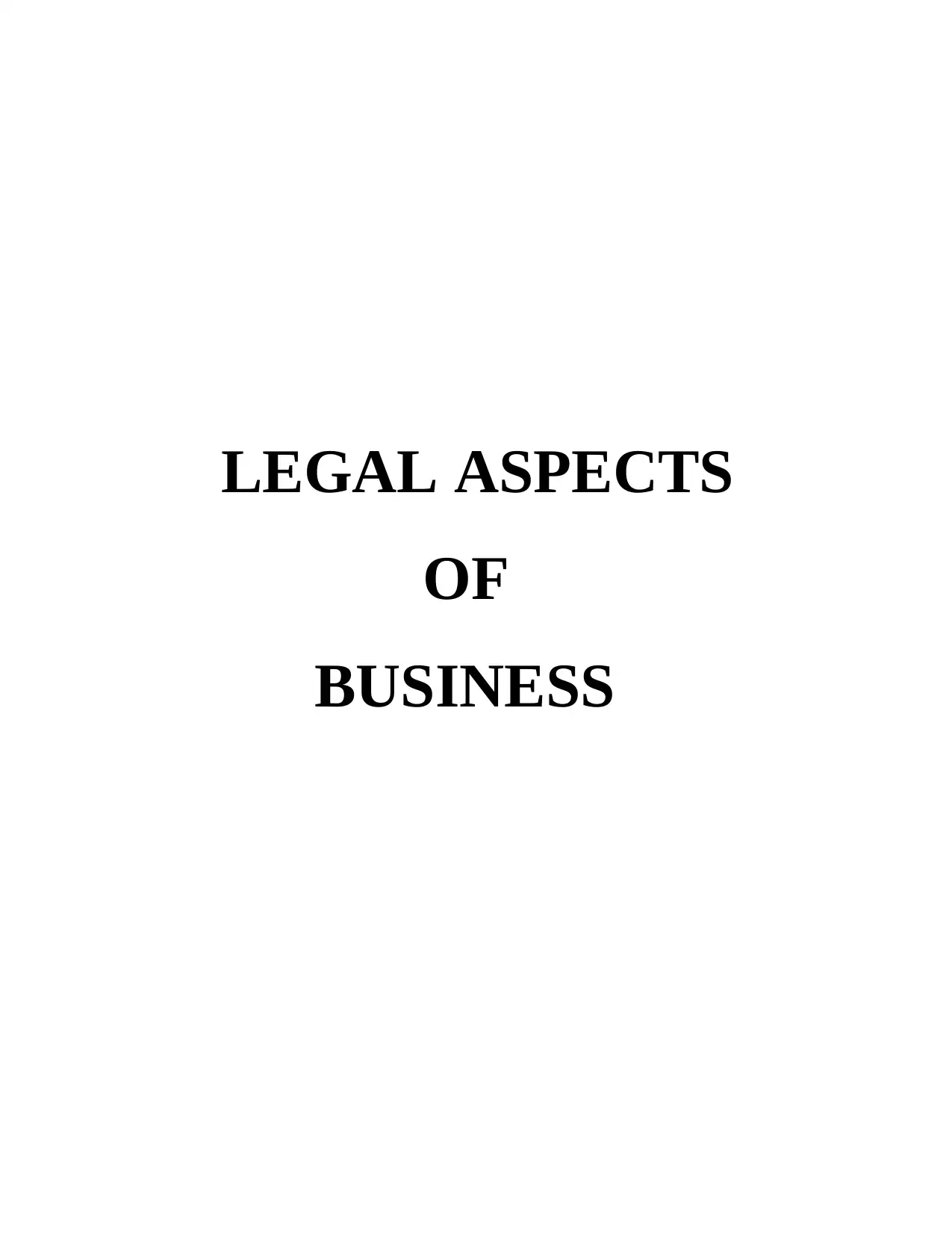
LEGAL ASPECTS
OF
BUSINESS
OF
BUSINESS
Paraphrase This Document
Need a fresh take? Get an instant paraphrase of this document with our AI Paraphraser
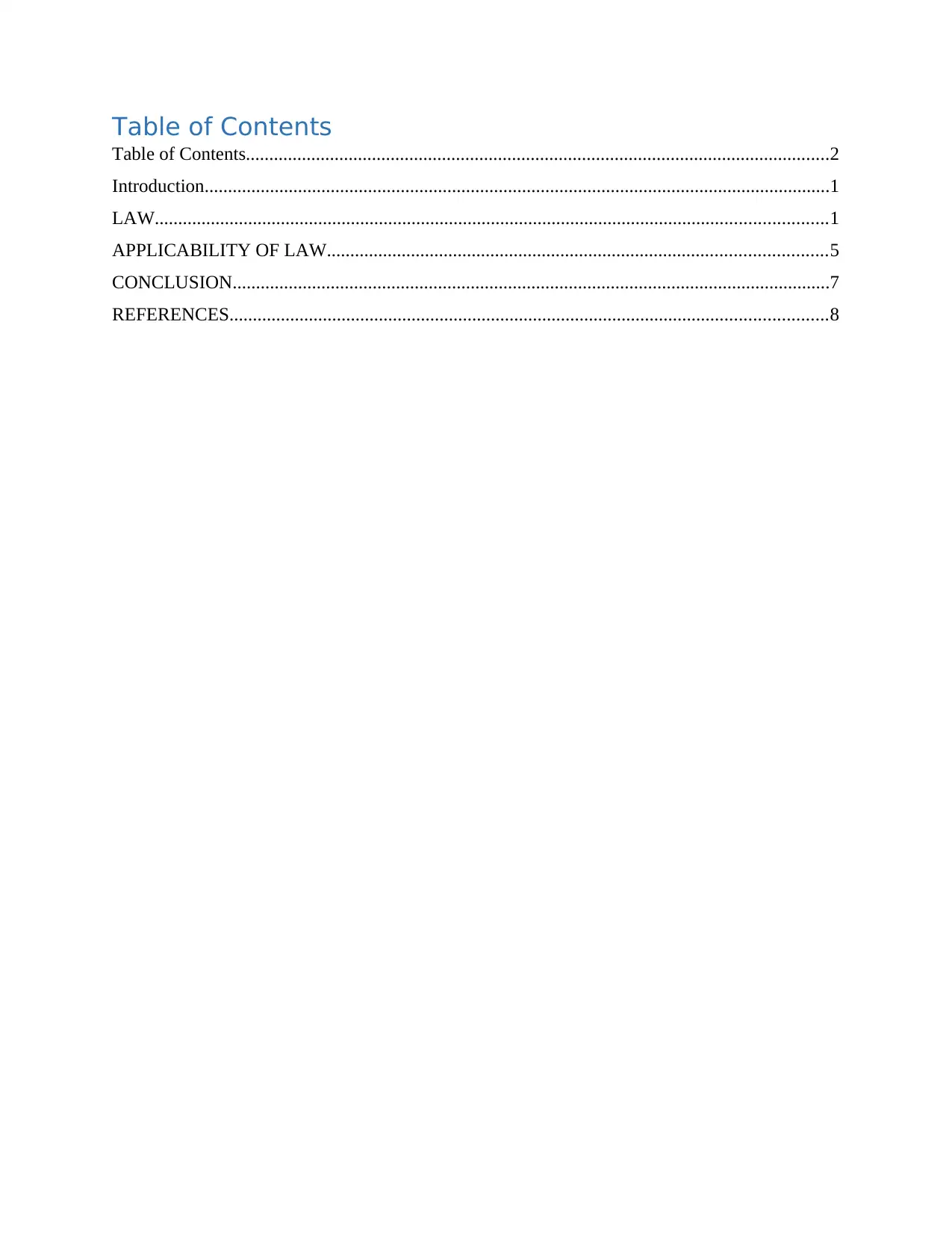
Table of Contents
Table of Contents.............................................................................................................................2
Introduction......................................................................................................................................1
LAW................................................................................................................................................1
APPLICABILITY OF LAW...........................................................................................................5
CONCLUSION................................................................................................................................7
REFERENCES................................................................................................................................8
Table of Contents.............................................................................................................................2
Introduction......................................................................................................................................1
LAW................................................................................................................................................1
APPLICABILITY OF LAW...........................................................................................................5
CONCLUSION................................................................................................................................7
REFERENCES................................................................................................................................8
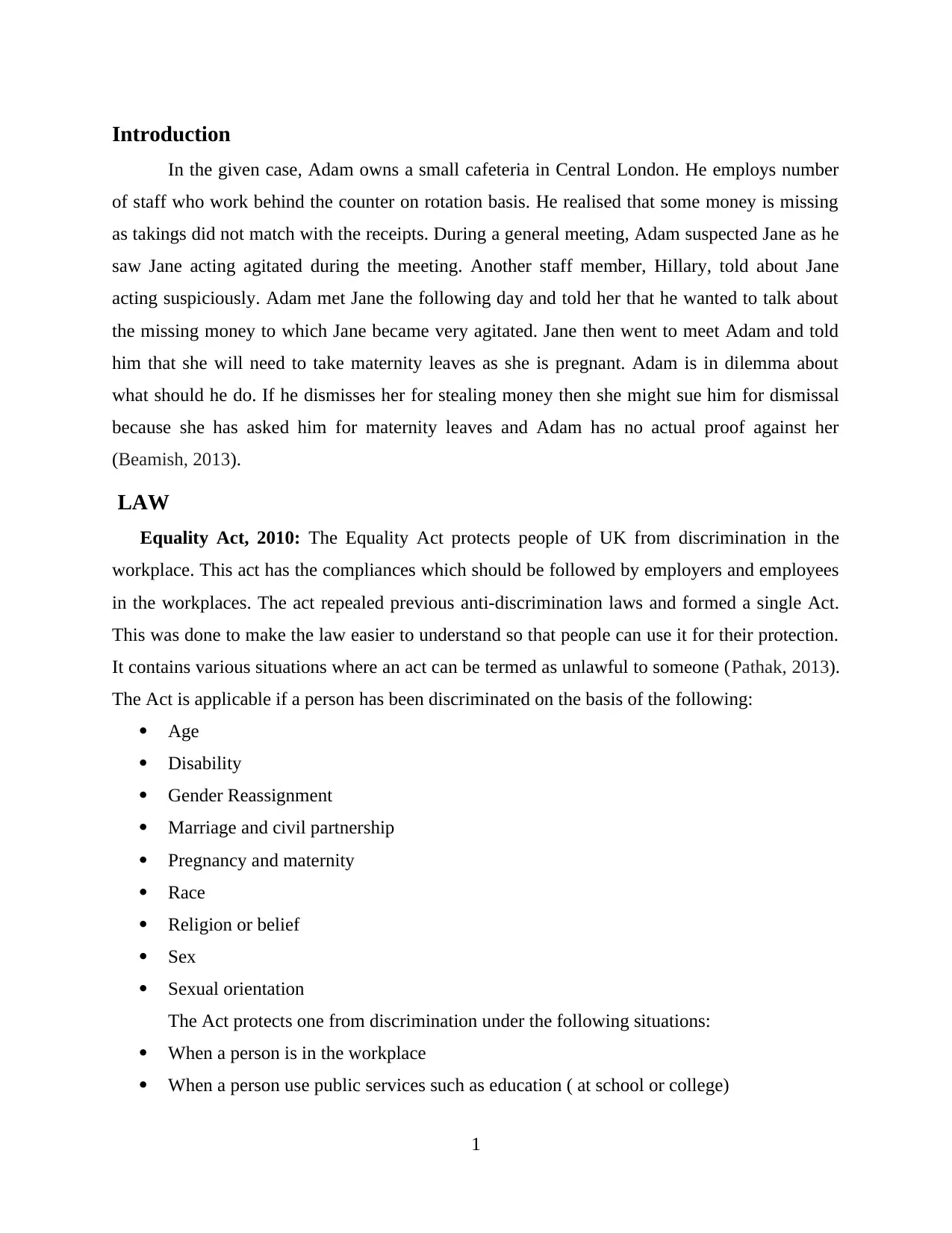
Introduction
In the given case, Adam owns a small cafeteria in Central London. He employs number
of staff who work behind the counter on rotation basis. He realised that some money is missing
as takings did not match with the receipts. During a general meeting, Adam suspected Jane as he
saw Jane acting agitated during the meeting. Another staff member, Hillary, told about Jane
acting suspiciously. Adam met Jane the following day and told her that he wanted to talk about
the missing money to which Jane became very agitated. Jane then went to meet Adam and told
him that she will need to take maternity leaves as she is pregnant. Adam is in dilemma about
what should he do. If he dismisses her for stealing money then she might sue him for dismissal
because she has asked him for maternity leaves and Adam has no actual proof against her
(Beamish, 2013).
LAW
Equality Act, 2010: The Equality Act protects people of UK from discrimination in the
workplace. This act has the compliances which should be followed by employers and employees
in the workplaces. The act repealed previous anti-discrimination laws and formed a single Act.
This was done to make the law easier to understand so that people can use it for their protection.
It contains various situations where an act can be termed as unlawful to someone (Pathak, 2013).
The Act is applicable if a person has been discriminated on the basis of the following:
Age
Disability
Gender Reassignment
Marriage and civil partnership
Pregnancy and maternity
Race
Religion or belief
Sex
Sexual orientation
The Act protects one from discrimination under the following situations:
When a person is in the workplace
When a person use public services such as education ( at school or college)
1
In the given case, Adam owns a small cafeteria in Central London. He employs number
of staff who work behind the counter on rotation basis. He realised that some money is missing
as takings did not match with the receipts. During a general meeting, Adam suspected Jane as he
saw Jane acting agitated during the meeting. Another staff member, Hillary, told about Jane
acting suspiciously. Adam met Jane the following day and told her that he wanted to talk about
the missing money to which Jane became very agitated. Jane then went to meet Adam and told
him that she will need to take maternity leaves as she is pregnant. Adam is in dilemma about
what should he do. If he dismisses her for stealing money then she might sue him for dismissal
because she has asked him for maternity leaves and Adam has no actual proof against her
(Beamish, 2013).
LAW
Equality Act, 2010: The Equality Act protects people of UK from discrimination in the
workplace. This act has the compliances which should be followed by employers and employees
in the workplaces. The act repealed previous anti-discrimination laws and formed a single Act.
This was done to make the law easier to understand so that people can use it for their protection.
It contains various situations where an act can be termed as unlawful to someone (Pathak, 2013).
The Act is applicable if a person has been discriminated on the basis of the following:
Age
Disability
Gender Reassignment
Marriage and civil partnership
Pregnancy and maternity
Race
Religion or belief
Sex
Sexual orientation
The Act protects one from discrimination under the following situations:
When a person is in the workplace
When a person use public services such as education ( at school or college)
1
⊘ This is a preview!⊘
Do you want full access?
Subscribe today to unlock all pages.

Trusted by 1+ million students worldwide
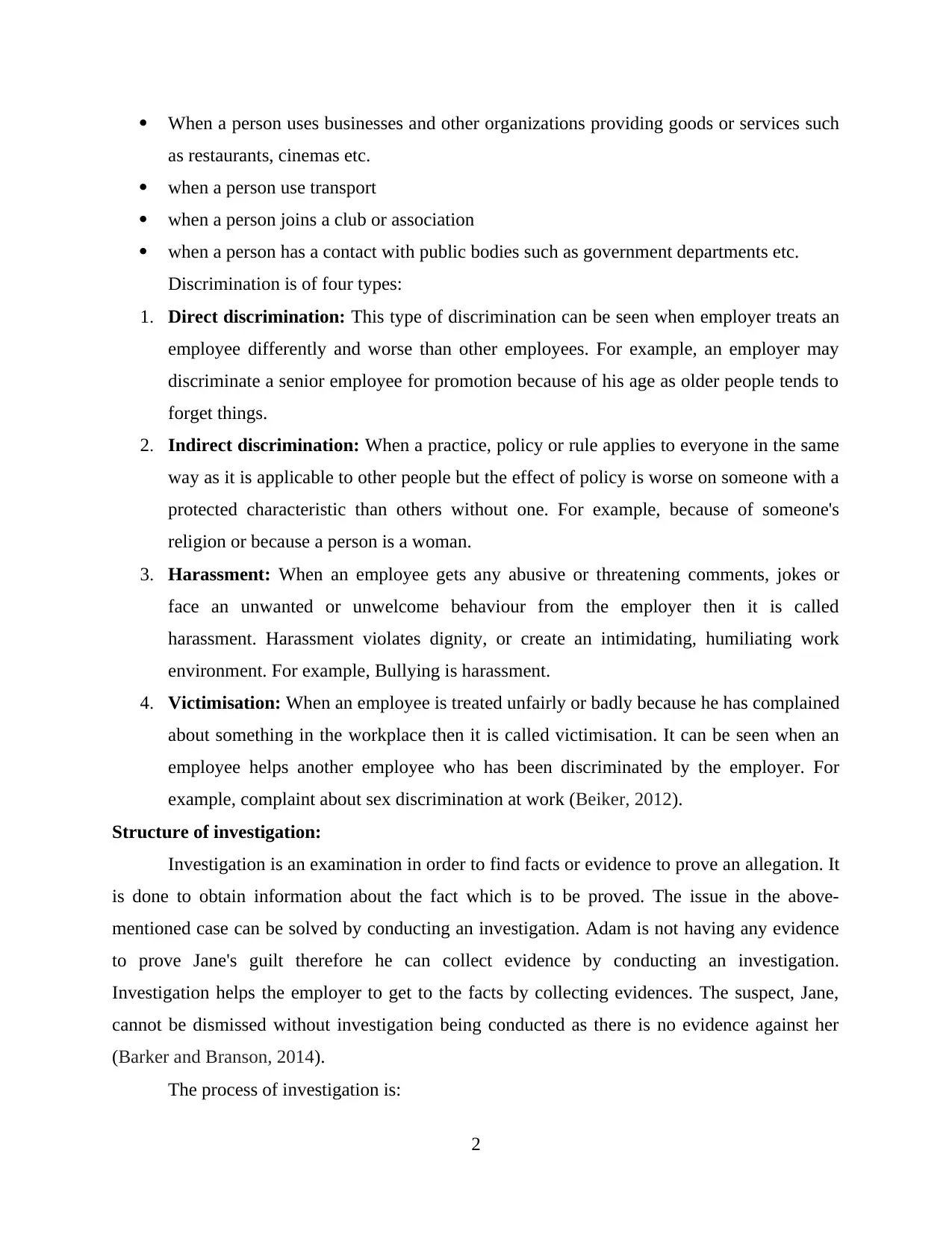
When a person uses businesses and other organizations providing goods or services such
as restaurants, cinemas etc.
when a person use transport
when a person joins a club or association
when a person has a contact with public bodies such as government departments etc.
Discrimination is of four types:
1. Direct discrimination: This type of discrimination can be seen when employer treats an
employee differently and worse than other employees. For example, an employer may
discriminate a senior employee for promotion because of his age as older people tends to
forget things.
2. Indirect discrimination: When a practice, policy or rule applies to everyone in the same
way as it is applicable to other people but the effect of policy is worse on someone with a
protected characteristic than others without one. For example, because of someone's
religion or because a person is a woman.
3. Harassment: When an employee gets any abusive or threatening comments, jokes or
face an unwanted or unwelcome behaviour from the employer then it is called
harassment. Harassment violates dignity, or create an intimidating, humiliating work
environment. For example, Bullying is harassment.
4. Victimisation: When an employee is treated unfairly or badly because he has complained
about something in the workplace then it is called victimisation. It can be seen when an
employee helps another employee who has been discriminated by the employer. For
example, complaint about sex discrimination at work (Beiker, 2012).
Structure of investigation:
Investigation is an examination in order to find facts or evidence to prove an allegation. It
is done to obtain information about the fact which is to be proved. The issue in the above-
mentioned case can be solved by conducting an investigation. Adam is not having any evidence
to prove Jane's guilt therefore he can collect evidence by conducting an investigation.
Investigation helps the employer to get to the facts by collecting evidences. The suspect, Jane,
cannot be dismissed without investigation being conducted as there is no evidence against her
(Barker and Branson, 2014).
The process of investigation is:
2
as restaurants, cinemas etc.
when a person use transport
when a person joins a club or association
when a person has a contact with public bodies such as government departments etc.
Discrimination is of four types:
1. Direct discrimination: This type of discrimination can be seen when employer treats an
employee differently and worse than other employees. For example, an employer may
discriminate a senior employee for promotion because of his age as older people tends to
forget things.
2. Indirect discrimination: When a practice, policy or rule applies to everyone in the same
way as it is applicable to other people but the effect of policy is worse on someone with a
protected characteristic than others without one. For example, because of someone's
religion or because a person is a woman.
3. Harassment: When an employee gets any abusive or threatening comments, jokes or
face an unwanted or unwelcome behaviour from the employer then it is called
harassment. Harassment violates dignity, or create an intimidating, humiliating work
environment. For example, Bullying is harassment.
4. Victimisation: When an employee is treated unfairly or badly because he has complained
about something in the workplace then it is called victimisation. It can be seen when an
employee helps another employee who has been discriminated by the employer. For
example, complaint about sex discrimination at work (Beiker, 2012).
Structure of investigation:
Investigation is an examination in order to find facts or evidence to prove an allegation. It
is done to obtain information about the fact which is to be proved. The issue in the above-
mentioned case can be solved by conducting an investigation. Adam is not having any evidence
to prove Jane's guilt therefore he can collect evidence by conducting an investigation.
Investigation helps the employer to get to the facts by collecting evidences. The suspect, Jane,
cannot be dismissed without investigation being conducted as there is no evidence against her
(Barker and Branson, 2014).
The process of investigation is:
2
Paraphrase This Document
Need a fresh take? Get an instant paraphrase of this document with our AI Paraphraser
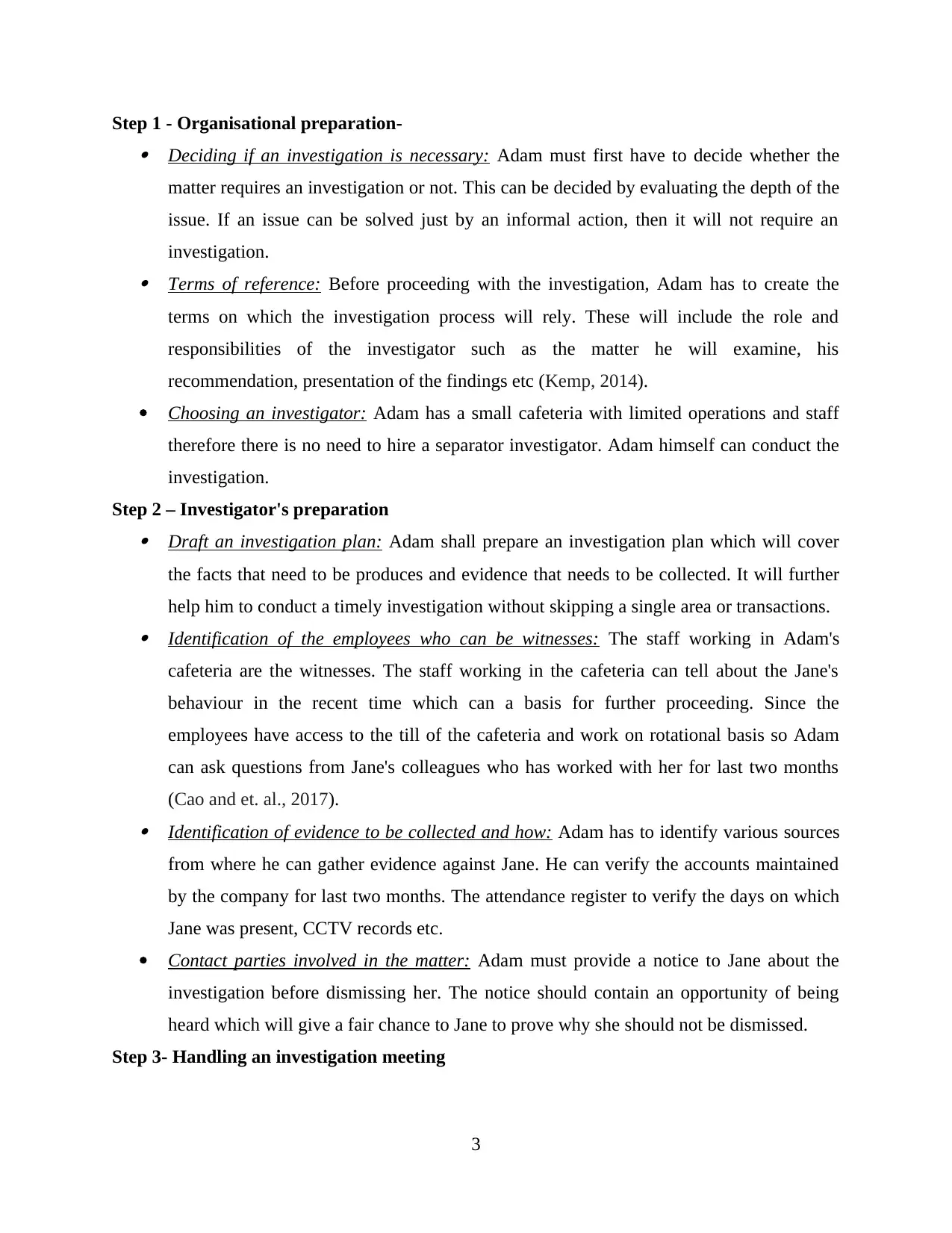
Step 1 - Organisational preparation- Deciding if an investigation is necessary: Adam must first have to decide whether the
matter requires an investigation or not. This can be decided by evaluating the depth of the
issue. If an issue can be solved just by an informal action, then it will not require an
investigation. Terms of reference: Before proceeding with the investigation, Adam has to create the
terms on which the investigation process will rely. These will include the role and
responsibilities of the investigator such as the matter he will examine, his
recommendation, presentation of the findings etc (Kemp, 2014).
Choosing an investigator: Adam has a small cafeteria with limited operations and staff
therefore there is no need to hire a separator investigator. Adam himself can conduct the
investigation.
Step 2 – Investigator's preparation Draft an investigation plan: Adam shall prepare an investigation plan which will cover
the facts that need to be produces and evidence that needs to be collected. It will further
help him to conduct a timely investigation without skipping a single area or transactions. Identification of the employees who can be witnesses: The staff working in Adam's
cafeteria are the witnesses. The staff working in the cafeteria can tell about the Jane's
behaviour in the recent time which can a basis for further proceeding. Since the
employees have access to the till of the cafeteria and work on rotational basis so Adam
can ask questions from Jane's colleagues who has worked with her for last two months
(Cao and et. al., 2017). Identification of evidence to be collected and how: Adam has to identify various sources
from where he can gather evidence against Jane. He can verify the accounts maintained
by the company for last two months. The attendance register to verify the days on which
Jane was present, CCTV records etc.
Contact parties involved in the matter: Adam must provide a notice to Jane about the
investigation before dismissing her. The notice should contain an opportunity of being
heard which will give a fair chance to Jane to prove why she should not be dismissed.
Step 3- Handling an investigation meeting
3
matter requires an investigation or not. This can be decided by evaluating the depth of the
issue. If an issue can be solved just by an informal action, then it will not require an
investigation. Terms of reference: Before proceeding with the investigation, Adam has to create the
terms on which the investigation process will rely. These will include the role and
responsibilities of the investigator such as the matter he will examine, his
recommendation, presentation of the findings etc (Kemp, 2014).
Choosing an investigator: Adam has a small cafeteria with limited operations and staff
therefore there is no need to hire a separator investigator. Adam himself can conduct the
investigation.
Step 2 – Investigator's preparation Draft an investigation plan: Adam shall prepare an investigation plan which will cover
the facts that need to be produces and evidence that needs to be collected. It will further
help him to conduct a timely investigation without skipping a single area or transactions. Identification of the employees who can be witnesses: The staff working in Adam's
cafeteria are the witnesses. The staff working in the cafeteria can tell about the Jane's
behaviour in the recent time which can a basis for further proceeding. Since the
employees have access to the till of the cafeteria and work on rotational basis so Adam
can ask questions from Jane's colleagues who has worked with her for last two months
(Cao and et. al., 2017). Identification of evidence to be collected and how: Adam has to identify various sources
from where he can gather evidence against Jane. He can verify the accounts maintained
by the company for last two months. The attendance register to verify the days on which
Jane was present, CCTV records etc.
Contact parties involved in the matter: Adam must provide a notice to Jane about the
investigation before dismissing her. The notice should contain an opportunity of being
heard which will give a fair chance to Jane to prove why she should not be dismissed.
Step 3- Handling an investigation meeting
3
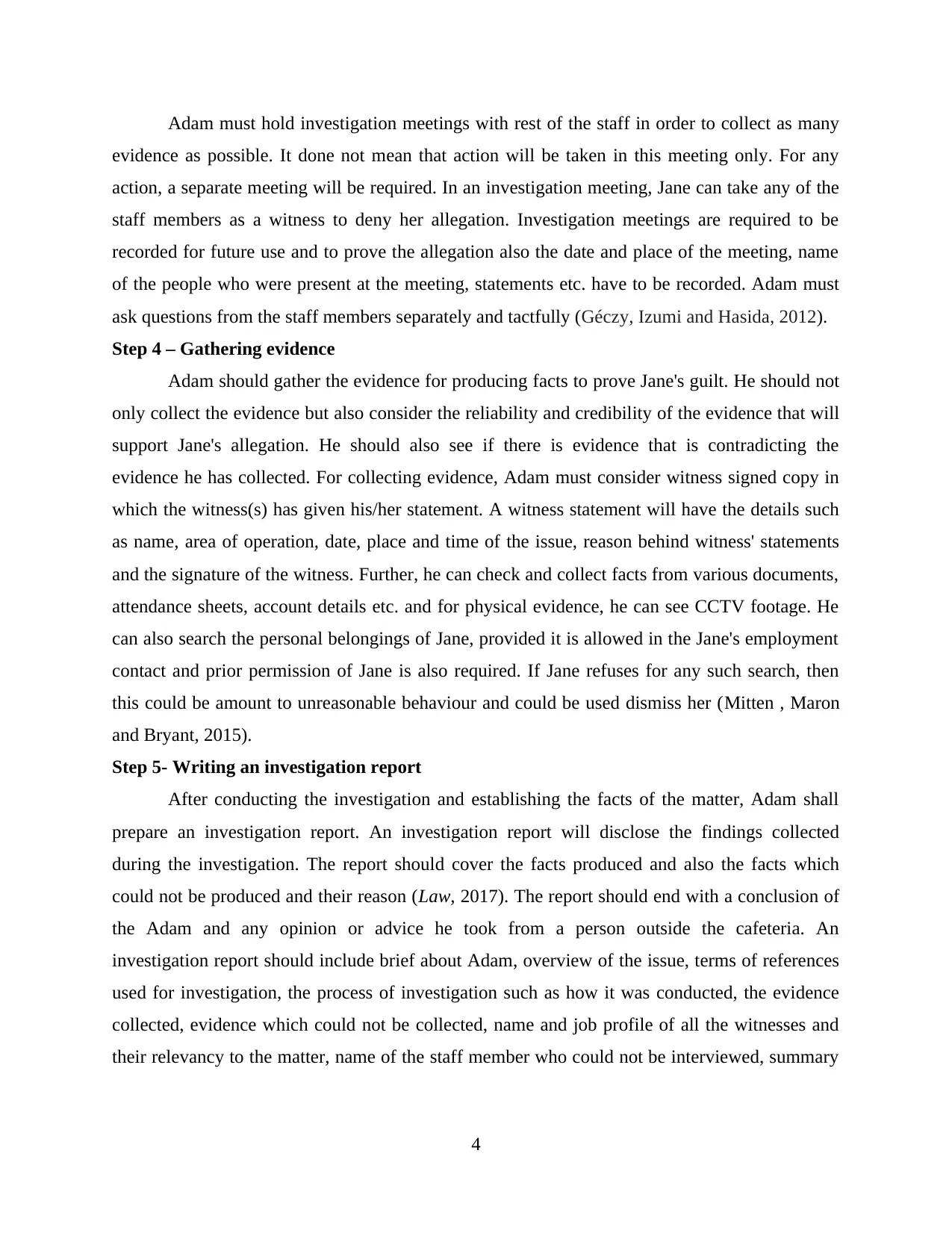
Adam must hold investigation meetings with rest of the staff in order to collect as many
evidence as possible. It done not mean that action will be taken in this meeting only. For any
action, a separate meeting will be required. In an investigation meeting, Jane can take any of the
staff members as a witness to deny her allegation. Investigation meetings are required to be
recorded for future use and to prove the allegation also the date and place of the meeting, name
of the people who were present at the meeting, statements etc. have to be recorded. Adam must
ask questions from the staff members separately and tactfully (Géczy, Izumi and Hasida, 2012).
Step 4 – Gathering evidence
Adam should gather the evidence for producing facts to prove Jane's guilt. He should not
only collect the evidence but also consider the reliability and credibility of the evidence that will
support Jane's allegation. He should also see if there is evidence that is contradicting the
evidence he has collected. For collecting evidence, Adam must consider witness signed copy in
which the witness(s) has given his/her statement. A witness statement will have the details such
as name, area of operation, date, place and time of the issue, reason behind witness' statements
and the signature of the witness. Further, he can check and collect facts from various documents,
attendance sheets, account details etc. and for physical evidence, he can see CCTV footage. He
can also search the personal belongings of Jane, provided it is allowed in the Jane's employment
contact and prior permission of Jane is also required. If Jane refuses for any such search, then
this could be amount to unreasonable behaviour and could be used dismiss her (Mitten , Maron
and Bryant, 2015).
Step 5- Writing an investigation report
After conducting the investigation and establishing the facts of the matter, Adam shall
prepare an investigation report. An investigation report will disclose the findings collected
during the investigation. The report should cover the facts produced and also the facts which
could not be produced and their reason (Law, 2017). The report should end with a conclusion of
the Adam and any opinion or advice he took from a person outside the cafeteria. An
investigation report should include brief about Adam, overview of the issue, terms of references
used for investigation, the process of investigation such as how it was conducted, the evidence
collected, evidence which could not be collected, name and job profile of all the witnesses and
their relevancy to the matter, name of the staff member who could not be interviewed, summary
4
evidence as possible. It done not mean that action will be taken in this meeting only. For any
action, a separate meeting will be required. In an investigation meeting, Jane can take any of the
staff members as a witness to deny her allegation. Investigation meetings are required to be
recorded for future use and to prove the allegation also the date and place of the meeting, name
of the people who were present at the meeting, statements etc. have to be recorded. Adam must
ask questions from the staff members separately and tactfully (Géczy, Izumi and Hasida, 2012).
Step 4 – Gathering evidence
Adam should gather the evidence for producing facts to prove Jane's guilt. He should not
only collect the evidence but also consider the reliability and credibility of the evidence that will
support Jane's allegation. He should also see if there is evidence that is contradicting the
evidence he has collected. For collecting evidence, Adam must consider witness signed copy in
which the witness(s) has given his/her statement. A witness statement will have the details such
as name, area of operation, date, place and time of the issue, reason behind witness' statements
and the signature of the witness. Further, he can check and collect facts from various documents,
attendance sheets, account details etc. and for physical evidence, he can see CCTV footage. He
can also search the personal belongings of Jane, provided it is allowed in the Jane's employment
contact and prior permission of Jane is also required. If Jane refuses for any such search, then
this could be amount to unreasonable behaviour and could be used dismiss her (Mitten , Maron
and Bryant, 2015).
Step 5- Writing an investigation report
After conducting the investigation and establishing the facts of the matter, Adam shall
prepare an investigation report. An investigation report will disclose the findings collected
during the investigation. The report should cover the facts produced and also the facts which
could not be produced and their reason (Law, 2017). The report should end with a conclusion of
the Adam and any opinion or advice he took from a person outside the cafeteria. An
investigation report should include brief about Adam, overview of the issue, terms of references
used for investigation, the process of investigation such as how it was conducted, the evidence
collected, evidence which could not be collected, name and job profile of all the witnesses and
their relevancy to the matter, name of the staff member who could not be interviewed, summary
4
⊘ This is a preview!⊘
Do you want full access?
Subscribe today to unlock all pages.

Trusted by 1+ million students worldwide
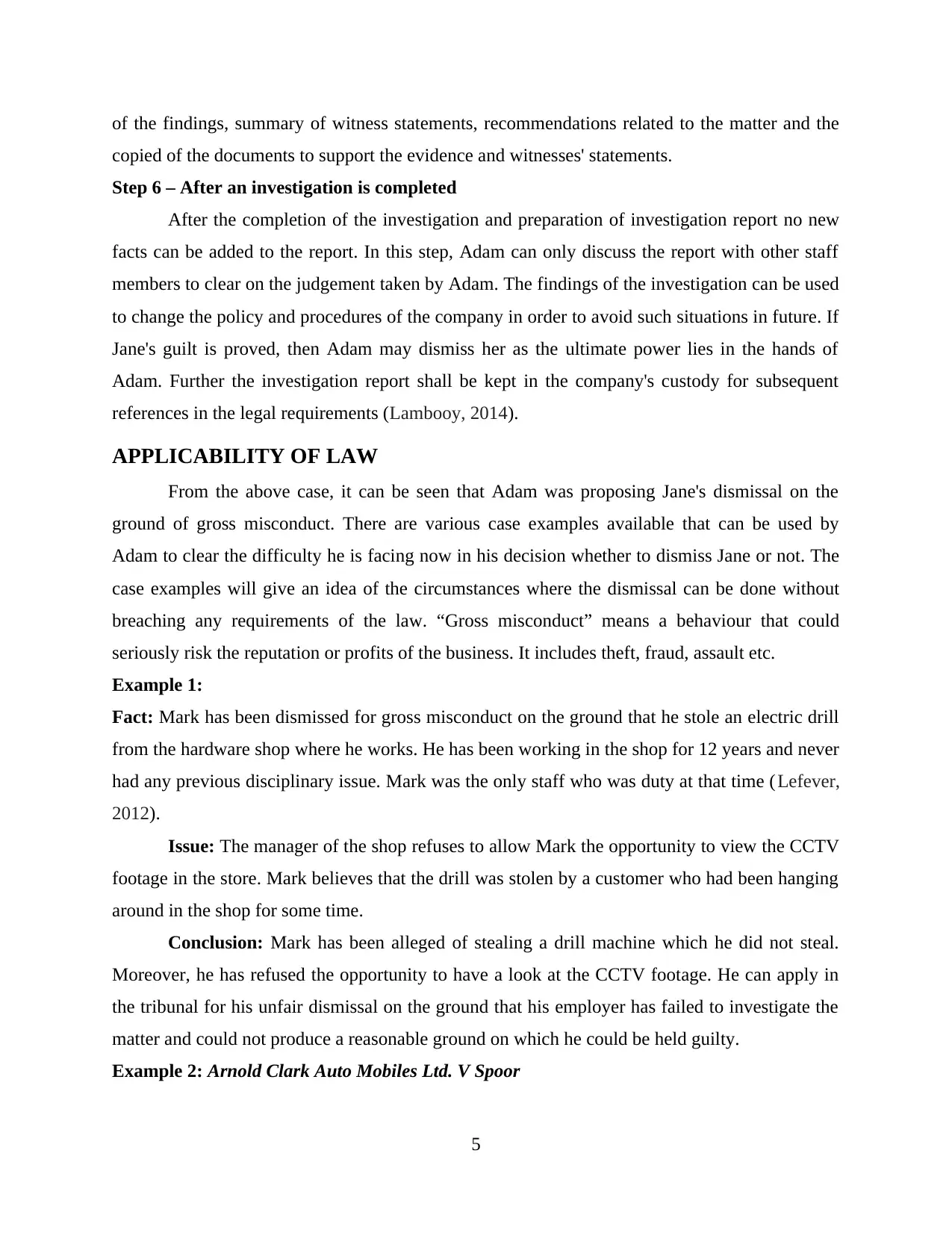
of the findings, summary of witness statements, recommendations related to the matter and the
copied of the documents to support the evidence and witnesses' statements.
Step 6 – After an investigation is completed
After the completion of the investigation and preparation of investigation report no new
facts can be added to the report. In this step, Adam can only discuss the report with other staff
members to clear on the judgement taken by Adam. The findings of the investigation can be used
to change the policy and procedures of the company in order to avoid such situations in future. If
Jane's guilt is proved, then Adam may dismiss her as the ultimate power lies in the hands of
Adam. Further the investigation report shall be kept in the company's custody for subsequent
references in the legal requirements (Lambooy, 2014).
APPLICABILITY OF LAW
From the above case, it can be seen that Adam was proposing Jane's dismissal on the
ground of gross misconduct. There are various case examples available that can be used by
Adam to clear the difficulty he is facing now in his decision whether to dismiss Jane or not. The
case examples will give an idea of the circumstances where the dismissal can be done without
breaching any requirements of the law. “Gross misconduct” means a behaviour that could
seriously risk the reputation or profits of the business. It includes theft, fraud, assault etc.
Example 1:
Fact: Mark has been dismissed for gross misconduct on the ground that he stole an electric drill
from the hardware shop where he works. He has been working in the shop for 12 years and never
had any previous disciplinary issue. Mark was the only staff who was duty at that time (Lefever,
2012).
Issue: The manager of the shop refuses to allow Mark the opportunity to view the CCTV
footage in the store. Mark believes that the drill was stolen by a customer who had been hanging
around in the shop for some time.
Conclusion: Mark has been alleged of stealing a drill machine which he did not steal.
Moreover, he has refused the opportunity to have a look at the CCTV footage. He can apply in
the tribunal for his unfair dismissal on the ground that his employer has failed to investigate the
matter and could not produce a reasonable ground on which he could be held guilty.
Example 2: Arnold Clark Auto Mobiles Ltd. V Spoor
5
copied of the documents to support the evidence and witnesses' statements.
Step 6 – After an investigation is completed
After the completion of the investigation and preparation of investigation report no new
facts can be added to the report. In this step, Adam can only discuss the report with other staff
members to clear on the judgement taken by Adam. The findings of the investigation can be used
to change the policy and procedures of the company in order to avoid such situations in future. If
Jane's guilt is proved, then Adam may dismiss her as the ultimate power lies in the hands of
Adam. Further the investigation report shall be kept in the company's custody for subsequent
references in the legal requirements (Lambooy, 2014).
APPLICABILITY OF LAW
From the above case, it can be seen that Adam was proposing Jane's dismissal on the
ground of gross misconduct. There are various case examples available that can be used by
Adam to clear the difficulty he is facing now in his decision whether to dismiss Jane or not. The
case examples will give an idea of the circumstances where the dismissal can be done without
breaching any requirements of the law. “Gross misconduct” means a behaviour that could
seriously risk the reputation or profits of the business. It includes theft, fraud, assault etc.
Example 1:
Fact: Mark has been dismissed for gross misconduct on the ground that he stole an electric drill
from the hardware shop where he works. He has been working in the shop for 12 years and never
had any previous disciplinary issue. Mark was the only staff who was duty at that time (Lefever,
2012).
Issue: The manager of the shop refuses to allow Mark the opportunity to view the CCTV
footage in the store. Mark believes that the drill was stolen by a customer who had been hanging
around in the shop for some time.
Conclusion: Mark has been alleged of stealing a drill machine which he did not steal.
Moreover, he has refused the opportunity to have a look at the CCTV footage. He can apply in
the tribunal for his unfair dismissal on the ground that his employer has failed to investigate the
matter and could not produce a reasonable ground on which he could be held guilty.
Example 2: Arnold Clark Auto Mobiles Ltd. V Spoor
5
Paraphrase This Document
Need a fresh take? Get an instant paraphrase of this document with our AI Paraphraser
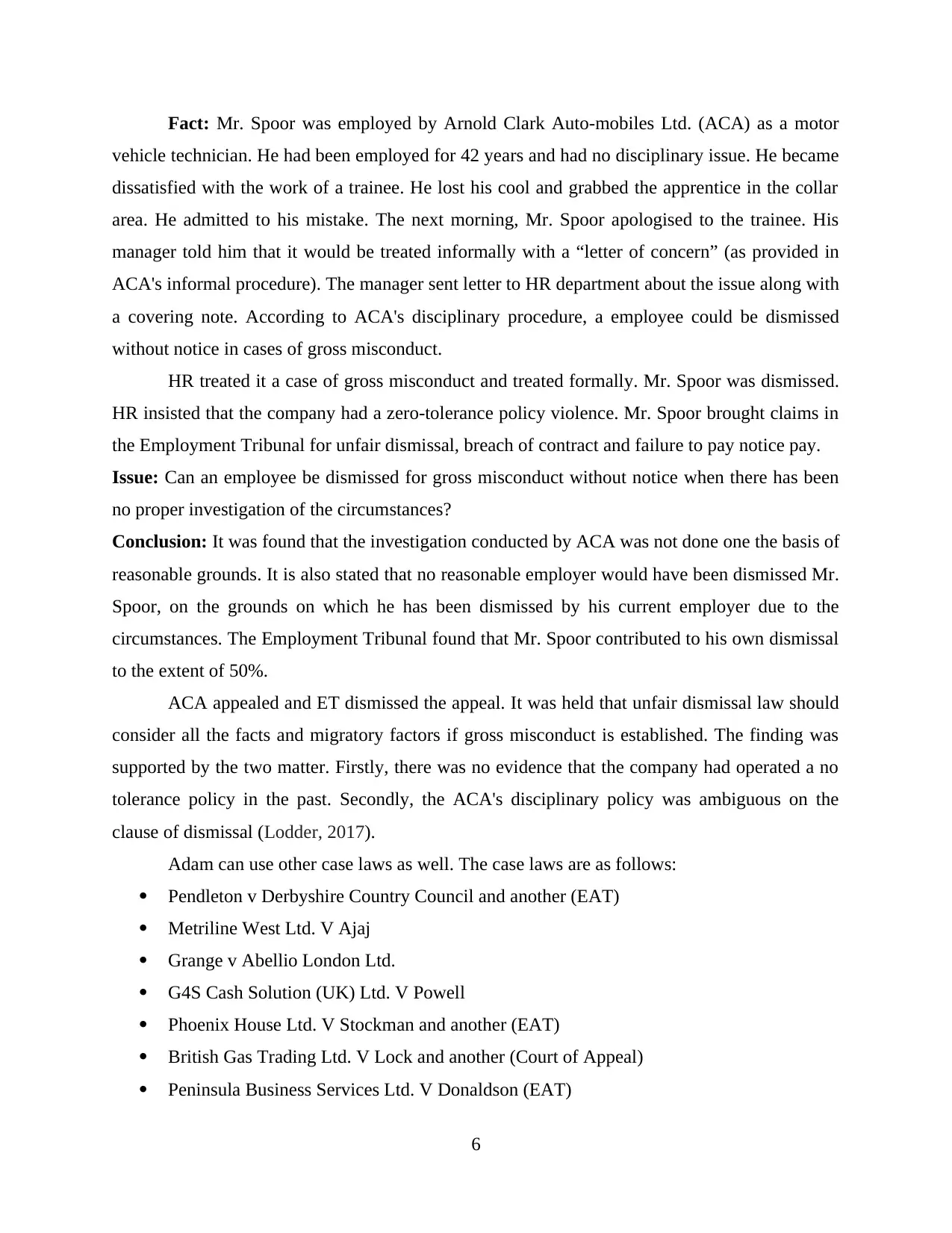
Fact: Mr. Spoor was employed by Arnold Clark Auto-mobiles Ltd. (ACA) as a motor
vehicle technician. He had been employed for 42 years and had no disciplinary issue. He became
dissatisfied with the work of a trainee. He lost his cool and grabbed the apprentice in the collar
area. He admitted to his mistake. The next morning, Mr. Spoor apologised to the trainee. His
manager told him that it would be treated informally with a “letter of concern” (as provided in
ACA's informal procedure). The manager sent letter to HR department about the issue along with
a covering note. According to ACA's disciplinary procedure, a employee could be dismissed
without notice in cases of gross misconduct.
HR treated it a case of gross misconduct and treated formally. Mr. Spoor was dismissed.
HR insisted that the company had a zero-tolerance policy violence. Mr. Spoor brought claims in
the Employment Tribunal for unfair dismissal, breach of contract and failure to pay notice pay.
Issue: Can an employee be dismissed for gross misconduct without notice when there has been
no proper investigation of the circumstances?
Conclusion: It was found that the investigation conducted by ACA was not done one the basis of
reasonable grounds. It is also stated that no reasonable employer would have been dismissed Mr.
Spoor, on the grounds on which he has been dismissed by his current employer due to the
circumstances. The Employment Tribunal found that Mr. Spoor contributed to his own dismissal
to the extent of 50%.
ACA appealed and ET dismissed the appeal. It was held that unfair dismissal law should
consider all the facts and migratory factors if gross misconduct is established. The finding was
supported by the two matter. Firstly, there was no evidence that the company had operated a no
tolerance policy in the past. Secondly, the ACA's disciplinary policy was ambiguous on the
clause of dismissal (Lodder, 2017).
Adam can use other case laws as well. The case laws are as follows:
Pendleton v Derbyshire Country Council and another (EAT)
Metriline West Ltd. V Ajaj
Grange v Abellio London Ltd.
G4S Cash Solution (UK) Ltd. V Powell
Phoenix House Ltd. V Stockman and another (EAT)
British Gas Trading Ltd. V Lock and another (Court of Appeal)
Peninsula Business Services Ltd. V Donaldson (EAT)
6
vehicle technician. He had been employed for 42 years and had no disciplinary issue. He became
dissatisfied with the work of a trainee. He lost his cool and grabbed the apprentice in the collar
area. He admitted to his mistake. The next morning, Mr. Spoor apologised to the trainee. His
manager told him that it would be treated informally with a “letter of concern” (as provided in
ACA's informal procedure). The manager sent letter to HR department about the issue along with
a covering note. According to ACA's disciplinary procedure, a employee could be dismissed
without notice in cases of gross misconduct.
HR treated it a case of gross misconduct and treated formally. Mr. Spoor was dismissed.
HR insisted that the company had a zero-tolerance policy violence. Mr. Spoor brought claims in
the Employment Tribunal for unfair dismissal, breach of contract and failure to pay notice pay.
Issue: Can an employee be dismissed for gross misconduct without notice when there has been
no proper investigation of the circumstances?
Conclusion: It was found that the investigation conducted by ACA was not done one the basis of
reasonable grounds. It is also stated that no reasonable employer would have been dismissed Mr.
Spoor, on the grounds on which he has been dismissed by his current employer due to the
circumstances. The Employment Tribunal found that Mr. Spoor contributed to his own dismissal
to the extent of 50%.
ACA appealed and ET dismissed the appeal. It was held that unfair dismissal law should
consider all the facts and migratory factors if gross misconduct is established. The finding was
supported by the two matter. Firstly, there was no evidence that the company had operated a no
tolerance policy in the past. Secondly, the ACA's disciplinary policy was ambiguous on the
clause of dismissal (Lodder, 2017).
Adam can use other case laws as well. The case laws are as follows:
Pendleton v Derbyshire Country Council and another (EAT)
Metriline West Ltd. V Ajaj
Grange v Abellio London Ltd.
G4S Cash Solution (UK) Ltd. V Powell
Phoenix House Ltd. V Stockman and another (EAT)
British Gas Trading Ltd. V Lock and another (Court of Appeal)
Peninsula Business Services Ltd. V Donaldson (EAT)
6
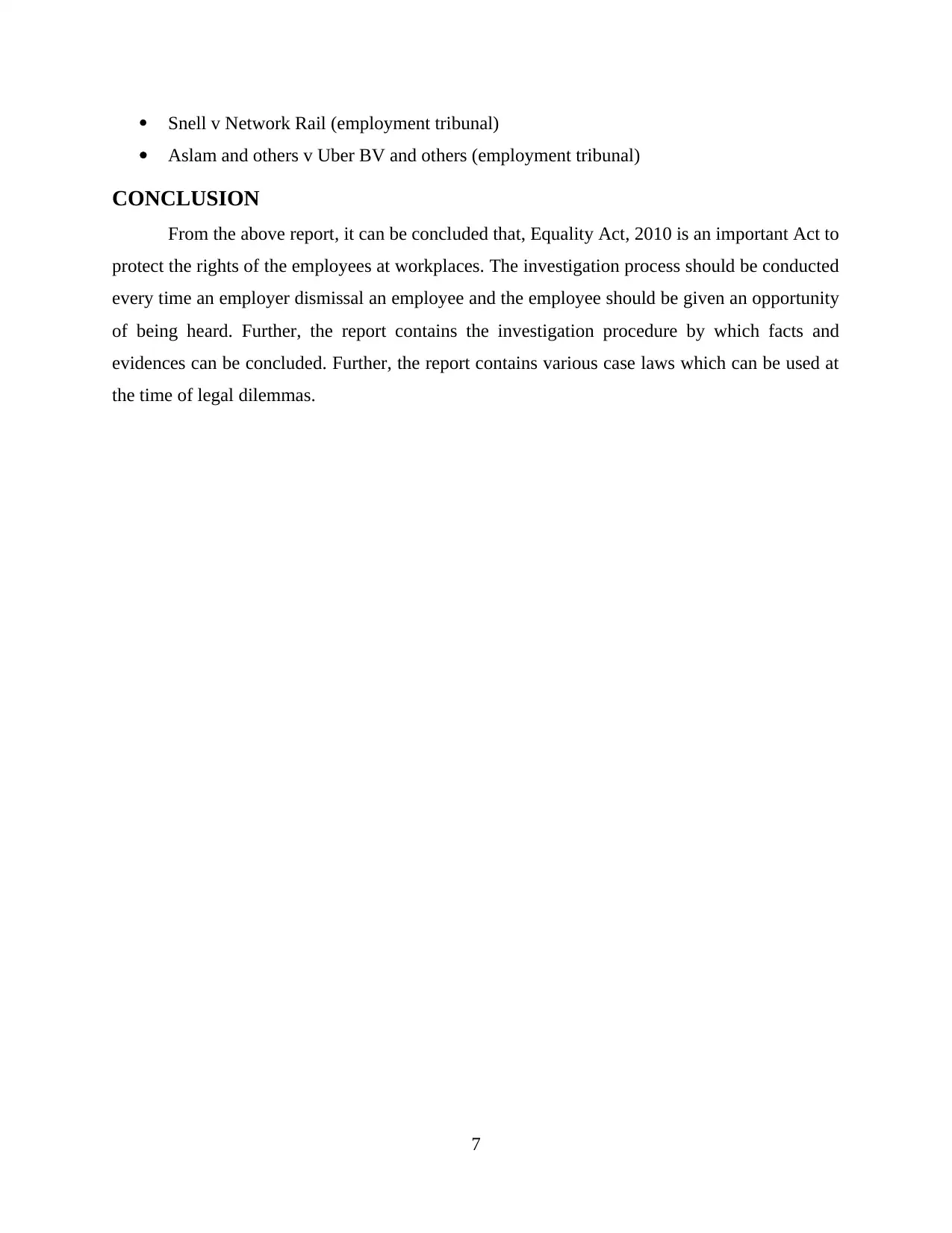
Snell v Network Rail (employment tribunal)
Aslam and others v Uber BV and others (employment tribunal)
CONCLUSION
From the above report, it can be concluded that, Equality Act, 2010 is an important Act to
protect the rights of the employees at workplaces. The investigation process should be conducted
every time an employer dismissal an employee and the employee should be given an opportunity
of being heard. Further, the report contains the investigation procedure by which facts and
evidences can be concluded. Further, the report contains various case laws which can be used at
the time of legal dilemmas.
7
Aslam and others v Uber BV and others (employment tribunal)
CONCLUSION
From the above report, it can be concluded that, Equality Act, 2010 is an important Act to
protect the rights of the employees at workplaces. The investigation process should be conducted
every time an employer dismissal an employee and the employee should be given an opportunity
of being heard. Further, the report contains the investigation procedure by which facts and
evidences can be concluded. Further, the report contains various case laws which can be used at
the time of legal dilemmas.
7
⊘ This is a preview!⊘
Do you want full access?
Subscribe today to unlock all pages.

Trusted by 1+ million students worldwide
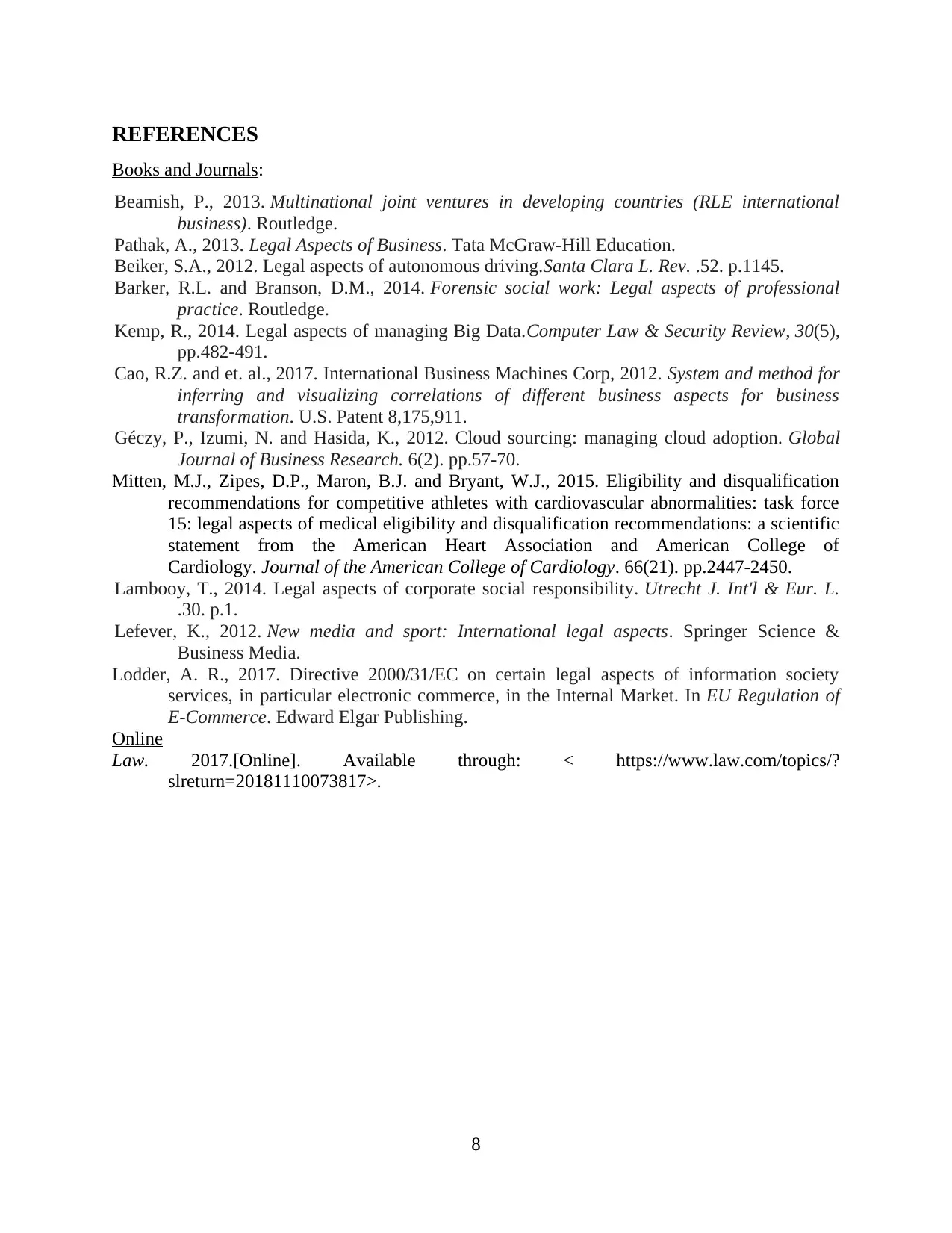
REFERENCES
Books and Journals:
Beamish, P., 2013. Multinational joint ventures in developing countries (RLE international
business). Routledge.
Pathak, A., 2013. Legal Aspects of Business. Tata McGraw-Hill Education.
Beiker, S.A., 2012. Legal aspects of autonomous driving.Santa Clara L. Rev. .52. p.1145.
Barker, R.L. and Branson, D.M., 2014. Forensic social work: Legal aspects of professional
practice. Routledge.
Kemp, R., 2014. Legal aspects of managing Big Data.Computer Law & Security Review, 30(5),
pp.482-491.
Cao, R.Z. and et. al., 2017. International Business Machines Corp, 2012. System and method for
inferring and visualizing correlations of different business aspects for business
transformation. U.S. Patent 8,175,911.
Géczy, P., Izumi, N. and Hasida, K., 2012. Cloud sourcing: managing cloud adoption. Global
Journal of Business Research. 6(2). pp.57-70.
Mitten, M.J., Zipes, D.P., Maron, B.J. and Bryant, W.J., 2015. Eligibility and disqualification
recommendations for competitive athletes with cardiovascular abnormalities: task force
15: legal aspects of medical eligibility and disqualification recommendations: a scientific
statement from the American Heart Association and American College of
Cardiology. Journal of the American College of Cardiology. 66(21). pp.2447-2450.
Lambooy, T., 2014. Legal aspects of corporate social responsibility. Utrecht J. Int'l & Eur. L.
.30. p.1.
Lefever, K., 2012. New media and sport: International legal aspects. Springer Science &
Business Media.
Lodder, A. R., 2017. Directive 2000/31/EC on certain legal aspects of information society
services, in particular electronic commerce, in the Internal Market. In EU Regulation of
E-Commerce. Edward Elgar Publishing.
Online
Law. 2017.[Online]. Available through: < https://www.law.com/topics/?
slreturn=20181110073817>.
8
Books and Journals:
Beamish, P., 2013. Multinational joint ventures in developing countries (RLE international
business). Routledge.
Pathak, A., 2013. Legal Aspects of Business. Tata McGraw-Hill Education.
Beiker, S.A., 2012. Legal aspects of autonomous driving.Santa Clara L. Rev. .52. p.1145.
Barker, R.L. and Branson, D.M., 2014. Forensic social work: Legal aspects of professional
practice. Routledge.
Kemp, R., 2014. Legal aspects of managing Big Data.Computer Law & Security Review, 30(5),
pp.482-491.
Cao, R.Z. and et. al., 2017. International Business Machines Corp, 2012. System and method for
inferring and visualizing correlations of different business aspects for business
transformation. U.S. Patent 8,175,911.
Géczy, P., Izumi, N. and Hasida, K., 2012. Cloud sourcing: managing cloud adoption. Global
Journal of Business Research. 6(2). pp.57-70.
Mitten, M.J., Zipes, D.P., Maron, B.J. and Bryant, W.J., 2015. Eligibility and disqualification
recommendations for competitive athletes with cardiovascular abnormalities: task force
15: legal aspects of medical eligibility and disqualification recommendations: a scientific
statement from the American Heart Association and American College of
Cardiology. Journal of the American College of Cardiology. 66(21). pp.2447-2450.
Lambooy, T., 2014. Legal aspects of corporate social responsibility. Utrecht J. Int'l & Eur. L.
.30. p.1.
Lefever, K., 2012. New media and sport: International legal aspects. Springer Science &
Business Media.
Lodder, A. R., 2017. Directive 2000/31/EC on certain legal aspects of information society
services, in particular electronic commerce, in the Internal Market. In EU Regulation of
E-Commerce. Edward Elgar Publishing.
Online
Law. 2017.[Online]. Available through: < https://www.law.com/topics/?
slreturn=20181110073817>.
8
1 out of 10
Related Documents
Your All-in-One AI-Powered Toolkit for Academic Success.
+13062052269
info@desklib.com
Available 24*7 on WhatsApp / Email
![[object Object]](/_next/static/media/star-bottom.7253800d.svg)
Unlock your academic potential
Copyright © 2020–2025 A2Z Services. All Rights Reserved. Developed and managed by ZUCOL.




